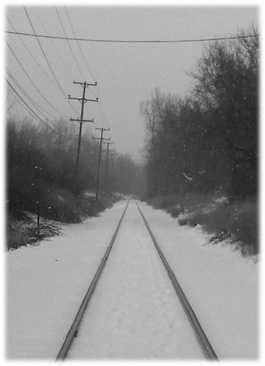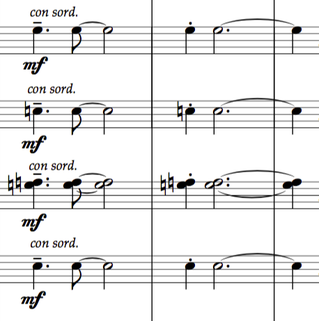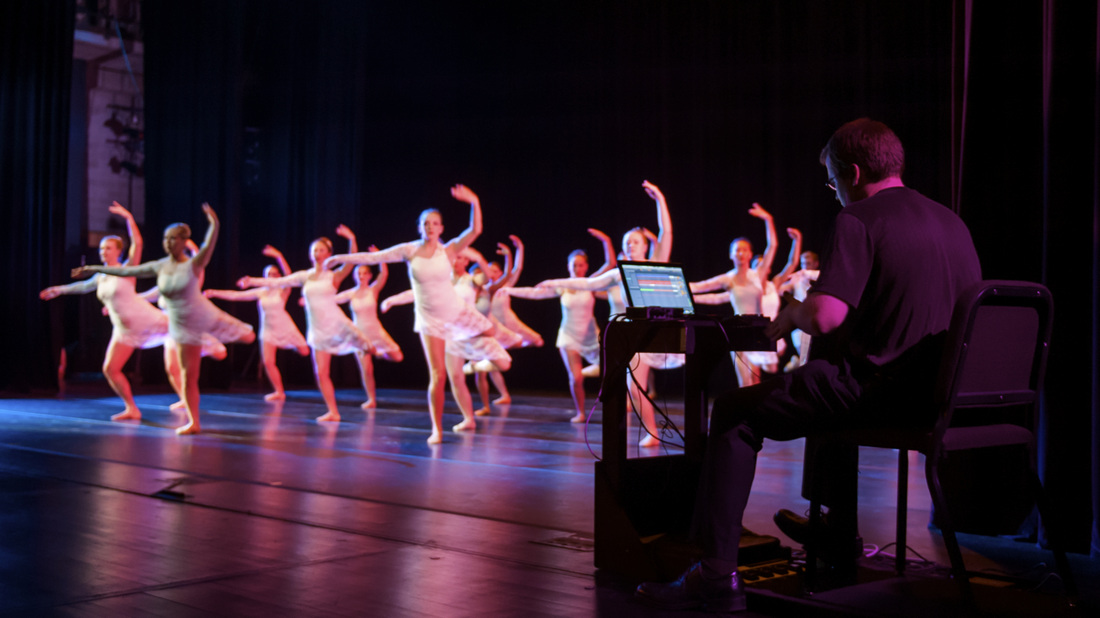It's time for an update, and by update I mean talking about some upcoming performances! This post will focus on an older work which will be getting a fair amount of playtime over the next several months, an orchestral piece called Tracks.
First, some background on the work. Tracks was written during my first semester of graduate work at Central Michigan University. My composition professor, David Gillingham, brought to my attention a contest being held by the Duluth-Superior Symphony for young composers. The task was to write a 6-minute orchestral overture to be performed by the group the following spring. He thought it would be a great challenge for me to try and get a large-scale work done in a few months (this was September, the contest's due date was in December). My still-naïve-new-grad-student mind thought "sure, this'll be a piece of cake," which within a week turned into "oh dear, what have I gotten into?" I had done a wind ensemble piece the year before, but the standard orchestral instrumentation and limited timeframe were something I had not encountered yet!
Thankfully, I got over my anxieties and got the piece finished just in time for the due date. It later went on to win first prize in the contest and was given its world premiere in Duluth in March of 2014. I also entered it into a contest by the Holland Symphony the following year, which was seeking appropriate piece that a youth orchestra could perform. I guess Tracks fit that bill too, since it also won first place! That specific performance is slotted for April 29th of 2017. The specific performance information can be viewed here (and you can even buy tickets for it already!). In the meantime, Tracks will be getting its Kansas debut next month by the Kansas State University Symphony Orchestra (which I was a part of all four years of my time there as an undergrad), led by Dr. David Littrell. That performance is free and specific info can be found here (concert starts at 7:30 PM).
I figured it wouldn't hurt to go into the guts of the piece a little in this post, but before doing so I recommend you listen to the piece first. I've put a MIDI rendering below (live performance advocates: my apologies, but I unfortunately didn't get a recording of the piece when it was premiered. That will change come September!)
First, some background on the work. Tracks was written during my first semester of graduate work at Central Michigan University. My composition professor, David Gillingham, brought to my attention a contest being held by the Duluth-Superior Symphony for young composers. The task was to write a 6-minute orchestral overture to be performed by the group the following spring. He thought it would be a great challenge for me to try and get a large-scale work done in a few months (this was September, the contest's due date was in December). My still-naïve-new-grad-student mind thought "sure, this'll be a piece of cake," which within a week turned into "oh dear, what have I gotten into?" I had done a wind ensemble piece the year before, but the standard orchestral instrumentation and limited timeframe were something I had not encountered yet!
Thankfully, I got over my anxieties and got the piece finished just in time for the due date. It later went on to win first prize in the contest and was given its world premiere in Duluth in March of 2014. I also entered it into a contest by the Holland Symphony the following year, which was seeking appropriate piece that a youth orchestra could perform. I guess Tracks fit that bill too, since it also won first place! That specific performance is slotted for April 29th of 2017. The specific performance information can be viewed here (and you can even buy tickets for it already!). In the meantime, Tracks will be getting its Kansas debut next month by the Kansas State University Symphony Orchestra (which I was a part of all four years of my time there as an undergrad), led by Dr. David Littrell. That performance is free and specific info can be found here (concert starts at 7:30 PM).
I figured it wouldn't hurt to go into the guts of the piece a little in this post, but before doing so I recommend you listen to the piece first. I've put a MIDI rendering below (live performance advocates: my apologies, but I unfortunately didn't get a recording of the piece when it was premiered. That will change come September!)
My overall intention for the piece was to pay homage to the diesel-powered trains which took over the rails from steam engines in the middle of the 20th century. I've grown up literally surrounded by trains, as my hometown of Olathe, Kansas has two extremely busy freight lines running through it. There are easily a dozen trains moving through a day, which acclimated my ears to their distinct mechanical rumbles and loud horn calls. My dad is also what you might consider a train nut, and I remember taking several trips on Amtrak (our nation's national rail service) with him throughout my childhood (and by myself throughout grad school, as it was cheaper to ride Amtrak home than fly!).
I also wanted to honor the very hard-working people who not only operate these vehicles, but who serve the thousands of rail travelers and maintain the thousands of miles of track in our country each year. Finally, the piece is written in memory of Shirley Craig, my paternal grandmother. A very kind and caring woman, Shirley was also quite a determined and independent sort of person whose character could best be described in terms of a diesel locomotive!
Now, onto how I made this train run! In terms of the piece's rhythmic content, I have two primary motives. The first is the "tracks" motive, meant to emulate the sound a train's wheels make when going over gaps in the track. The original form (shown below) makes its appearance in the low strings at 0:17 and is continually heard in some form or another throughout the piece.
I also wanted to honor the very hard-working people who not only operate these vehicles, but who serve the thousands of rail travelers and maintain the thousands of miles of track in our country each year. Finally, the piece is written in memory of Shirley Craig, my paternal grandmother. A very kind and caring woman, Shirley was also quite a determined and independent sort of person whose character could best be described in terms of a diesel locomotive!
Now, onto how I made this train run! In terms of the piece's rhythmic content, I have two primary motives. The first is the "tracks" motive, meant to emulate the sound a train's wheels make when going over gaps in the track. The original form (shown below) makes its appearance in the low strings at 0:17 and is continually heard in some form or another throughout the piece.
Probably the easiest place to hear the rhythm changed is when the main theme is stated at 0:30. Here, the note values are stretched out to include quarter- and half-notes, then eighth-notes.
The other rhythmic idea is what I call the "signal" motive, which duplicates the long-long-short-long series of horn blasts a train makes as it approaches a crossing. One firsts hears this in the brass at the piece's outset, but like the "tracks" motive this rhythm constantly shows up both unchanged (for when I want to show the musical "train" approaching) and rhythmically augmented or diminished.
Moving onto melodic and harmonic material, I decided to infuse the piece with the pitches of the Airchime K5LA, which is widely used on Amtrak trains as well as freight engines. The five pitches (D#, F#, G#, B, high D#) are almost the same as a B pentatonic scale (missing the C#), so I decided to set the piece in B major at the outset.
Now, those of you with perfect pitch maybe caught the fact that none of those five pitches were heard when the "horn" sounds at :07. This is intentional, and so is the dramatic pitch slide into the "correct" pitches at :16. Here, I was mimicking the Doppler Effect, which increases the pitch of an approaching sound source relative to a listener, then gradually lowers it as the source passes by the listener. I allude to the effect twice more throughout the piece, once at the key change to E-flat major at 2:17-18 (where the tonic note of B slides into B-flat, the fifth of the new tonic chord), then again at the piece's conclusion at about 5:15-16.
Formally, the piece follows the fast-slow-fast sectional format of a concert overture. I'm not going to go into much more detail than that (this post is FAR too long already!), but I will say the transition from fast to slow occurs from around 2:10 to 2:20, then the return to a quicker tempo happens abruptly at 4:23.
I know this isn't an exhaustive, graduate-level analysis, but hopefully I got the gist of the piece across. My goal was to use just a few compositional elements (as described above) to create a complete and entertaining "ride" for both listeners and performers. I encourage you to listen to the piece several times and try and catch all the various implementations of said elements!
Now, those of you with perfect pitch maybe caught the fact that none of those five pitches were heard when the "horn" sounds at :07. This is intentional, and so is the dramatic pitch slide into the "correct" pitches at :16. Here, I was mimicking the Doppler Effect, which increases the pitch of an approaching sound source relative to a listener, then gradually lowers it as the source passes by the listener. I allude to the effect twice more throughout the piece, once at the key change to E-flat major at 2:17-18 (where the tonic note of B slides into B-flat, the fifth of the new tonic chord), then again at the piece's conclusion at about 5:15-16.
Formally, the piece follows the fast-slow-fast sectional format of a concert overture. I'm not going to go into much more detail than that (this post is FAR too long already!), but I will say the transition from fast to slow occurs from around 2:10 to 2:20, then the return to a quicker tempo happens abruptly at 4:23.
I know this isn't an exhaustive, graduate-level analysis, but hopefully I got the gist of the piece across. My goal was to use just a few compositional elements (as described above) to create a complete and entertaining "ride" for both listeners and performers. I encourage you to listen to the piece several times and try and catch all the various implementations of said elements!





 RSS Feed
RSS Feed